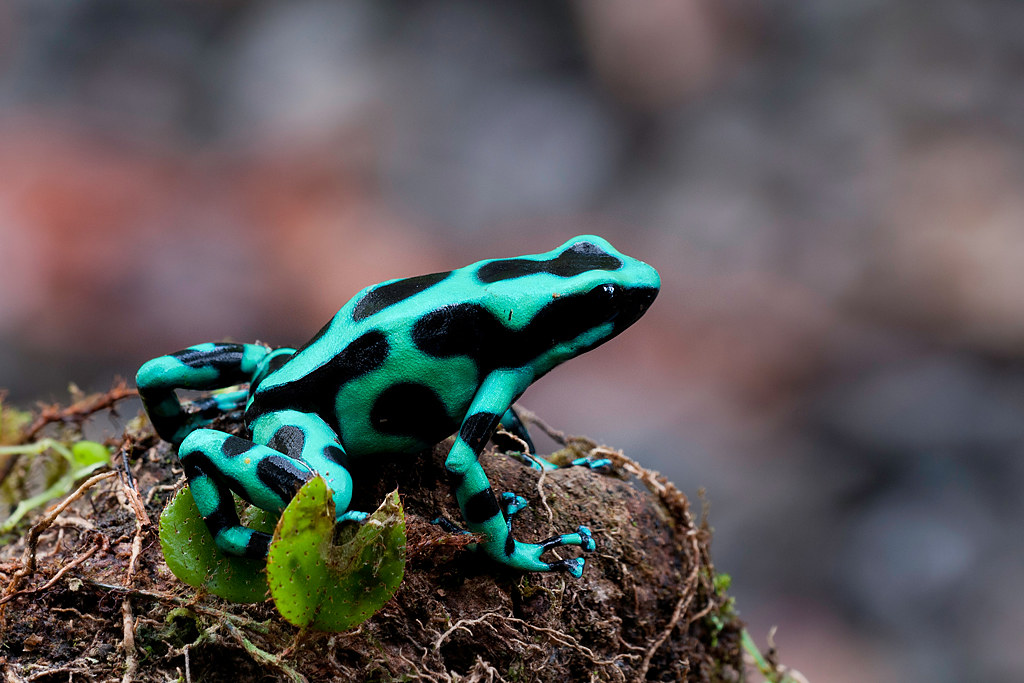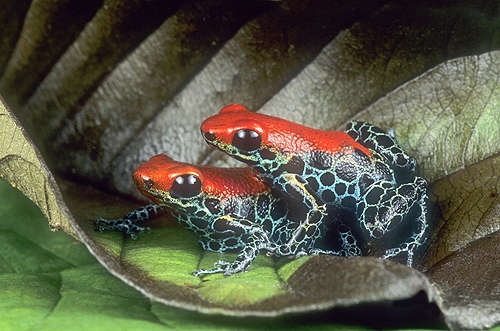Dendrobates
Dyer Frog ( Dendrobates tinctorius )
The poison frog ( Dendrobates of δένδρος = " tree " and βαινω = " board ") is a genus within the family of the poison dart frog ( Dendrobatidae ) represents a further genus in this family include the sheet Steiger ( Phyllobates ). The term poison dart is also used synonymously for the whole family of Dendrobatidae.
Features
The Baumsteiger have bright colors and body but poisonous secretions on their skin. Unlike other genres, they have no dorsal stripe or lateral longitudinal stripes. The skin on the back is smooth. The species of the genus do not have webbed feet, but holdfasts. The first finger is shorter than the second, in the males of the third finger is not thickened.
The set of chromosomes is in this genus Baumsteiger in diploid cells of 18 chromosomes ( 2n = 18). In other species of the family of poison dart up to 30 chromosomes are present.
Occurrence
Native to the Frogs are in the humid Latin American tropics and subtropics from Nicaragua to the southeast of Brazil and Bolivia.
Way of life
In the skin surface toxic alkaloids are embedded. These are, however, as in the related poison dart frogs, not made of tree climbers themselves, but have their basis in the diet. They are originally synthesized by insects, millipedes or mites, which are eaten by the frogs. To which prey this is exactly is, is not yet clear. It is also unclear how far the recorded alkaloids in the metabolism of frogs can be reformed. In the terrarium with the usual feeding it with fruit flies or crickets skin toxins of the poison dart does not occur.
The males of the Baumsteiger carry the tadpoles to the waters where they develop further. The type Dendrobates leucomelas brings the larvae in small surface waters. The species Dendrobates auratus and Dendrobates truncatus subject to availability either surface water or phytotelmata caused by rain water inside the bromeliads funnel. The tadpoles of other species are found exclusively in the plant hoppers.
Taxonomy
The genus Dendrobates was described in 1830 by Johann Georg Wagler in his work Natural system of amphibians.
Species
After revisions to the classification of poison dart frogs of the genus Dendrobates formerly rich in forms only five species are listed under this taxon, the others were assigned to numerous new genera:
- Dendrobates auratus ( Girard, 1855) - Gold Baumsteiger
- Dendrobates leucomelas Steindachner, 1864 - Yellow-Banded Poison Frog
- Dendrobates nubeculosus maid and Böhme, 2004
- Dendrobates tinctorius ( Cuvier, 1797) - Dyer frog ( type species )
- Dendrobates truncatus ( Cope, 1861)
The previous way Dendrobates azureus Hoogmoed, 1969 ( Blue poison frog ) is now only as a color variant of the dyer frog ( above) viewed.
Most previous Dendrobates species are now sorted taxonomically different. Several genera were spun off, now they form the subfamily Dendrobatinae within the family of poison dart frog:
- Dendrobates Grant, Frost, Caldwell, Gagliardo, Haddad, Kok, Means, Noonan, Schargel & Wheeler, 2006
- Andinobates Twomey, Brown, Amézquita & Mejía - Vargas, 2011
- Dendrobates Wagler, 1830
- Excidobates Twomey and Brown, 2008
- Minyobates Myers, 1987
- Oophaga Bauer, 1994
- Phyllobates Duméril and Bibron, 1841
- Ranitomeya Bauer, 1986










